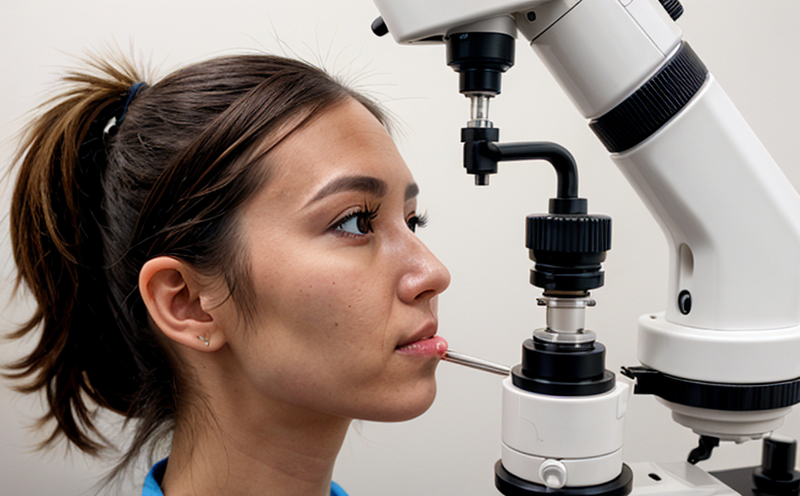ASTM F756 Hemolysis Testing of Ophthalmic Implant Materials
The ASTM F756 test method is a critical procedure in the development and quality assurance of ophthalmic implants, particularly those made from materials that come into direct contact with blood. This test evaluates the potential for hemolysis, or the breakdown of red blood cells, due to interactions between the implant material and blood constituents. Hemolysis can lead to serious complications such as anemia, thrombosis, and other adverse effects on patient health.
The ASTM F756 protocol involves exposing a sample of the ophthalmic implant material to a controlled volume of human blood under specific conditions. After a defined incubation period, the sample is analyzed for hemolysis by measuring the concentration of released hemoglobin in the blood. The test provides critical data that helps manufacturers ensure their products meet stringent safety and efficacy standards.
The procedure adheres strictly to ASTM F756-18a, which specifies the method for determining the resistance of certain implant materials to hemolysis. This standard ensures consistency and comparability across different laboratories involved in the testing process. Compliance with this test is essential not only for ensuring product safety but also for obtaining regulatory approvals from bodies such as the U.S. Food and Drug Administration (FDA).
The testing process involves a series of well-defined steps that are crucial for accurate results:
- Preparation of Specimens: The ophthalmic implant material is cut into small, uniform pieces to ensure consistent exposure during the test.
- Contact with Blood: Specimens are immersed in human blood under controlled conditions that mimic physiological environments as closely as possible.
- Incubation Period: Samples remain in contact with the blood for a specified duration, allowing sufficient time for any hemolytic reactions to occur.
- Measurement of Hemolysis: After incubation, the released hemoglobin is quantified using spectrophotometric methods. This measurement helps determine the hemolysis index (HI), which indicates the material's tendency to cause hemolysis.
The ASTM F756 test results provide valuable insights into the biocompatibility of ophthalmic implant materials, helping manufacturers refine their products and improve patient outcomes. By adhering to this rigorous testing protocol, companies can ensure that their devices meet regulatory requirements and are safe for clinical use.
In summary, ASTM F756 hemolysis testing is a cornerstone in the development and quality assurance of ophthalmic implants. Its importance cannot be overstated, as it directly impacts patient safety and satisfaction. This test ensures that materials used in these critical medical devices do not compromise blood integrity, thereby reducing the risk of severe adverse effects.
Understanding the ASTM F756 standard is essential for those involved in ophthalmic device research and development, quality assurance, and compliance. By leveraging this testing method, manufacturers can develop safe, effective, and compliant products that meet both regulatory expectations and clinical needs.
Why It Matters
The ASTM F756 hemolysis test is crucial for several reasons:
- Patient Safety: Hemolysis can lead to severe health complications, including anemia and thrombosis. Ensuring that ophthalmic implant materials do not cause hemolysis is paramount.
- Regulatory Compliance: Regulatory bodies such as the FDA require compliance with standards like ASTM F756 for the approval of medical devices. Non-compliance can lead to product recalls and legal issues.
- Improved Device Efficacy: By identifying materials prone to hemolysis, manufacturers can innovate and improve their products, leading to better patient outcomes.
- Patient Trust: Reputable testing ensures that the medical devices used in ophthalmic procedures are safe and reliable, enhancing patient trust.
The ASTM F756 test is a vital step in the development and quality assurance of ophthalmic implants. It helps ensure that these critical medical devices do not compromise blood integrity, thereby reducing the risk of severe adverse effects on patients.
Why Choose This Test
Selecting ASTM F756 hemolysis testing for your ophthalmic device development is a strategic decision with multiple benefits:
- Scientific Rigor: The test adheres to stringent international standards, ensuring accurate and reliable results.
- Industry Recognition: Compliance with ASTM F756 is recognized globally in the medical device industry as a benchmark for quality and safety.
- Regulatory Approval: Meeting this standard increases the likelihood of regulatory approval from bodies such as the FDA, which can expedite product launch timelines.
- Patient Safety: By identifying hemolytic materials early in development, you ensure that your products do not pose risks to patients.
- Competitive Advantage: Demonstrating adherence to this standard differentiates your products from competitors and positions them as leaders in patient safety and quality.
- Continuous Improvement: The results of ASTM F756 testing provide valuable data that can be used to refine materials and processes, leading to ongoing product improvement.
The ASTM F756 test is an indispensable tool for ensuring the safety and efficacy of ophthalmic implant materials. By choosing this test, you are committing to excellence in your product development process.
Quality and Reliability Assurance
- Consistency Across Laboratories: ASTM F756 ensures that testing results are consistent across different laboratories by providing clear protocols and standardized procedures.
- Data Integrity: The test method provides robust data that can be relied upon for decision-making processes in product development.
- Long-Term Reliability: By identifying hemolytic materials early, you ensure that your products remain safe over the long term, even under various conditions of use.
- Risk Mitigation: Early detection of hemolysis risks through ASTM F756 testing helps mitigate potential product recalls and associated costs.
- Enhanced Reputation: Demonstrating adherence to international standards enhances your company's reputation in the medical device industry, fostering trust with customers and partners.
The ASTM F756 hemolysis test is a key component of any comprehensive quality assurance program. By ensuring that your ophthalmic devices meet this rigorous standard, you are investing in long-term patient safety and product reliability.





